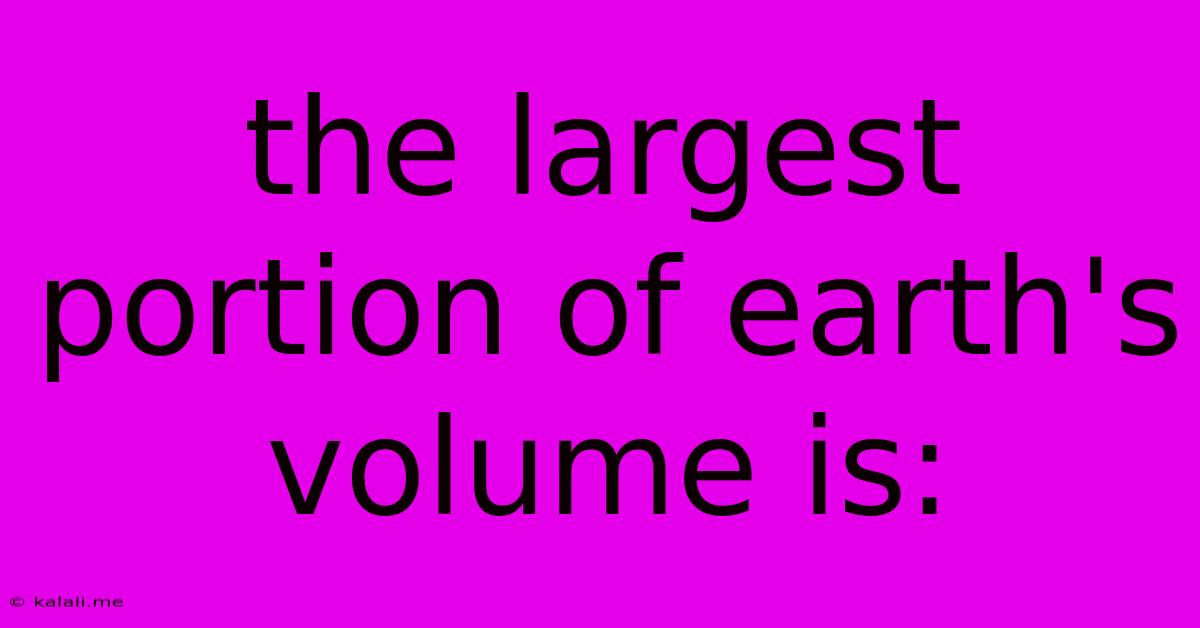The Largest Portion Of Earth's Volume Is:
Kalali
Jun 13, 2025 · 3 min read

Table of Contents
The Largest Portion of Earth's Volume: Unveiling the Mantle's Mighty Mass
The Earth, our vibrant and dynamic planet, is a complex system composed of several layers. But which layer holds the lion's share of Earth's impressive volume? The answer might surprise you, it's not the crust we walk on, nor the core at the planet's heart. The dominant player in Earth's volume game is the mantle, a vast, mostly solid region that accounts for the largest portion of our planet's total volume.
This article delves into the fascinating world of Earth's internal structure, explaining why the mantle reigns supreme in terms of volume, and exploring its significant role in shaping the planet's geological processes.
Earth's Layered Structure: A Brief Overview
Before we dive into the mantle's dominance, let's briefly revisit the key layers that constitute our planet:
- Crust: The outermost layer, thin and brittle, forming the continents and ocean floors. It's relatively insignificant in terms of volume.
- Mantle: A thick layer primarily composed of silicate rocks. This is where the bulk of Earth's volume resides.
- Outer Core: A liquid layer composed primarily of iron and nickel. While substantial in volume, it's still smaller than the mantle.
- Inner Core: A solid sphere, also primarily iron and nickel, subjected to immense pressure. Its volume is smaller than both the mantle and outer core.
The Mantle: A Giant in the Earth's Interior
The mantle is by far the largest layer, encompassing approximately 84% of Earth's total volume. This massive layer extends from the base of the crust to the outer core, reaching a depth of approximately 2,900 kilometers (1,802 miles). Its immense size is responsible for the majority of Earth's mass. The mantle isn't a homogenous entity; it’s further divided into the upper and lower mantle, each exhibiting distinct physical properties and chemical compositions.
Why is the Mantle so Large?
The sheer scale of the mantle is a consequence of the planet's formation process. During Earth's early history, denser materials sank towards the center, forming the core. Lighter materials rose to form the crust, leaving the vast intermediate space occupied by the mantle. This process of differentiation, driven by gravitational forces and heat, resulted in the layered structure we observe today, with the mantle emerging as the dominant layer in terms of volume.
The Mantle's Role in Geological Processes
The mantle isn't just a passive reservoir of rock; it plays a vital role in several crucial geological processes:
- Plate Tectonics: The movement of tectonic plates is driven by convection currents within the mantle. Heat rising from the core causes mantle material to rise, spread, and then cool and sink, creating a cycle that drives plate motion, earthquakes, and volcanic activity.
- Volcanism: Magma, molten rock from the mantle, rises to the surface through volcanic eruptions, shaping landscapes and releasing gases into the atmosphere.
- Mountain Building: The collision of tectonic plates, driven by mantle convection, leads to the uplift of mountain ranges.
Conclusion: The Mantle's Reign
In conclusion, while the Earth's core might be intriguing and the crust readily observable, it's the mantle that truly holds the title of the largest portion of Earth's volume. Understanding the mantle's composition, structure, and dynamics is crucial to comprehending the planet's geological history, present-day processes, and future evolution. Its immense size and active role in shaping our world make it a truly fascinating subject of study for geologists and earth scientists alike.
Latest Posts
Latest Posts
-
A Body Of Land With Water On Three Sides
Jun 14, 2025
-
How To Submit Sat Scores To Colleges
Jun 14, 2025
-
A Group Of Cells Is Called A
Jun 14, 2025
-
What Is Difference Between Tort And Crime
Jun 14, 2025
-
How To Calculate The Average Force
Jun 14, 2025
Related Post
Thank you for visiting our website which covers about The Largest Portion Of Earth's Volume Is: . We hope the information provided has been useful to you. Feel free to contact us if you have any questions or need further assistance. See you next time and don't miss to bookmark.